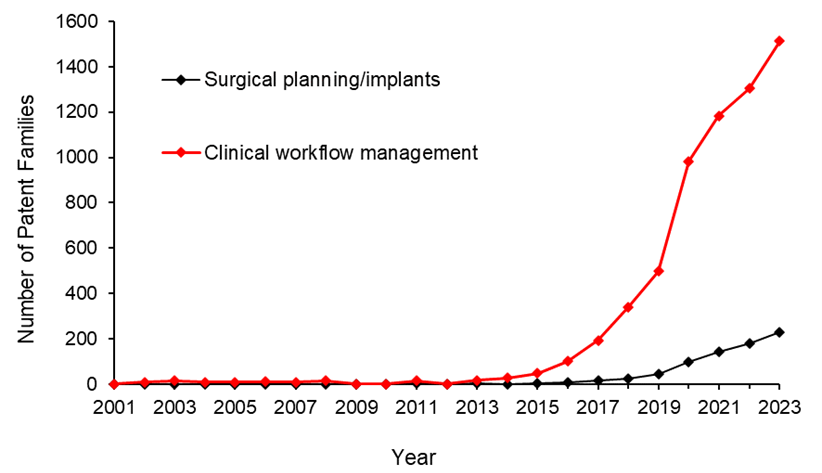AI Research
Trends in patent filing for artificial intelligence-assisted medical technologies | Smart & Biggar

[co-authors: Jessica Lee, Noam Amitay and Sarah McLaughlin]
Medical technologies incorporating artificial intelligence (AI) are an emerging area of innovation with the potential to transform healthcare. Employing techniques such as machine learning, deep learning and natural language processing,1 AI enables machine-based systems that can make predictions, recommendations or decisions that influence real or virtual environments based on a given set of objectives.2 For example, AI-based medical systems can collect medical data, analyze medical data and assist in medical treatment, or provide informed recommendations or decisions.3 According to the U.S. Food and Drug Administration (FDA), some key areas in which AI are applied in medical devices include: 4
- Image acquisition and processing
- Diagnosis, prognosis, and risk assessment
- Early disease detection
- Identification of new patterns in human physiology and disease progression
- Development of personalized diagnostics
- Therapeutic treatment response monitoring
Patent filing data related to these application areas can help us see emerging trends.
Table of contents
Analysis strategy
We identified nine subcategories of interest:
- Image acquisition and processing
- Medical image acquisition
- Pre-processing of medical imaging
- Pattern recognition and classification for image-based diagnosis
- Diagnosis, prognosis and risk management
- Early disease detection
- Identification of new patterns in physiology and disease
- Development of personalized diagnostics and medicine
- Therapeutic treatment response monitoring
- Clinical workflow management
- Surgical planning/implants
We searched patent filings in each subcategory from 2001 to 2023. In the results below, the number of patent filings are based on patent families, each patent family being a collection of patent documents covering the same technology, which have at least one priority document in common.5
What has been filed over the years?
The number of patents filed in each subcategory of AI-assisted applications for medical technologies from 2001 to 2023 is shown below.
We see that patenting activities are concentrating in the areas of treatment response monitoring, identification of new patterns in physiology and disease, clinical workflow management, pattern recognition and classification for image-based diagnosis, and development of personalized diagnostics and medicine. This suggests that research and development efforts are focused on these areas.
What do the annual numbers tell us?
Let’s look at the annual number of patent filings for the categories and subcategories listed above. The following four graphs show the global patent filing trends over time for the categories of AI-assisted medical technologies related to: image acquisition and processing; diagnosis, prognosis and risk management; treatment response monitoring; and workflow management.
When looking at the patent filings on an annual basis, the numbers confirm the expected significant uptick in patenting activities in recent years for all categories searched. They also show that, within the four categories, the subcategories showing the fastest rate of growth were: pattern recognition and classification for image-based diagnosis, identification of new patterns in human physiology and disease, treatment response monitoring, and clinical workflow management.

Above: Global patent filing trends over time for categories of AI-assisted medical technologies related to image acquisition and processing.

Above: Global patent filing trends over time for categories of AI-assisted medical technologies related to more accurate diagnosis, prognosis and risk management.

Above: Global patent filing trends over time for AI-assisted medical technologies related to treatment response monitoring.

Above: Global patent filing trends over time for categories of AI-assisted medical technologies related to workflow management.
Where is R&D happening?
By looking at where the inventors are located, we can see where R&D activities are occurring. We found that the two most frequent inventor locations are the United States (50.3%) and China (26.2%). Both Australia and Canada are amongst the ten most frequent inventor locations, with Canada ranking seventh and Australia ranking ninth in the five subcategories that have the highest patenting activities from 2001-2023.

Where are the destination markets?
The filing destinations provide a clue as to the intended markets or locations of commercial partnerships. The United States (30.6%) and China (29.4%) again are the pace leaders. Canada is the seventh most frequent destination jurisdiction with 3.2% of patent filings. Australia is the eighth most frequent destination jurisdiction with 3.1% of patent filings.

Takeaways
Our analysis found that the leading subcategories of AI-assisted medical technology patent applications from 2001 to 2023 include treatment response monitoring, identification of new patterns in human physiology and disease, clinical workflow management, pattern recognition and classification for image-based diagnosis as well as development of personalized diagnostics and medicine.
In more recent years, we found the fastest growth in the areas of pattern recognition and classification for image-based diagnosis, identification of new patterns in human physiology and disease, treatment response monitoring, and clinical workflow management, suggesting that R&D efforts are being concentrated in these areas.
We saw that patent filings in the areas of early disease detection and surgical/implant monitoring increased later than the other categories, suggesting these may be emerging areas of growth.
Although, as expected, the United States and China are consistently the leading jurisdictions in both inventor location and destination patent offices, Canada and Australia are frequently in the top ten.
Patent intelligence provides powerful tools for decision makers in looking at what might be shaping our future. With recent geopolitical changes and policy updates in key primary markets, as well as shifts in trade relationships, patent filings give us insight into how these aspects impact innovation. For everyone, it provides exciting clues as to what emerging technologies may shape our lives.
References
1. Alowais et.al., Revolutionizing healthcare: the role of artificial intelligence in clinical practice (2023), BMC Medical Education, 23:689.
2. U.S. Food and Drug Administration (FDA), Artificial Intelligence and Machine Learning in Software as a Medical Device.
3. Bitkina et.al., Application of artificial intelligence in medical technologies: a systematic review of main trends (2023), Digital Health, 9:1-15.
4. Artificial Intelligence Program: Research on AI/ML-Based Medical Devices | FDA.
5. INPADOC extended patent family.
[View source.]
AI Research
Inside Austin’s Gauntlet AI, the Elite Bootcamp Forging “AI First” Builders

AUSTIN, Texas — In the brave new world of artificial intelligence, talent is the new gold, and companies are in a frantic race to find it. While universities work to churn out computer science graduates, a new kind of school has emerged in Austin to meet the insatiable demand: Gauntlet AI.
Gauntlet AI bills itself as an elite training program. It’s a high-stakes, high-reward process designed to forge “AI-first” engineers and builders in a matter of weeks.
“We’re closer to Navy SEAL bootcamp training than a school,” said Ash Tilawat, Head of Product and Learning. “We take the smartest people in the world. We bring them into the same place for a 1000 hours over ten weeks and we make them go all in with building with AI.”
Austen Allred, the co-founder and CEO of Gauntlet AI, says when they claim to be looking for the smartest engineers in the world, it’s no exaggeration. The selection process is intensely rigorous.
“We accept around 2 percent of the applicants,” Allred explained. “We accept 98th percentile and above of raw intelligence, 95th percentile of coding ability, and then you start on The Gauntlet.”
ALSO| The 60-Second Guardian: Can a Swarm of Drones Stop a School Shooter?
The price of admission isn’t paid in dollars—there are no tuition fees. Instead, the cost is a student’s absolute, undivided attention.
“It is pretty grueling, but it’s invigorating and I love doing this,” said Nataly Smith, one of the “Gauntlet Challengers.”
Smith, whose passions lie in biotech and space, recently channeled her love for bioscience to complete one of the program’s challenges. Her team was tasked with building a project called “Geno.”
“It’s a tool where a person can upload their genomic data and get a statistical analysis of how likely they are to have different kinds of cancers,” Smith described.
Incredibly, her team built the AI-powered tool in just one week.
The ultimate prize waiting at the end of the grueling 10-week gauntlet is a guaranteed job offer with a starting salary of at least $200,000 a year. And hiring partners are already lining up to recruit challengers like Nataly.
“We very intentionally chose to partner with everything from seed-stage startups all the way to publicly traded companies,” said Brett Johnson, Gauntlet’s COO. “So Carvana is a hiring partner. Here in Austin, we have folks like Function Health. We have the Trilogy organization; we have Capital Factory just around the corner. We’re big into the Austin tech community and looking to double down on that.”
In a world desperate for skilled engineers, Gauntlet AI isn’t just training people; it’s manufacturing the very talent pipeline it believes will power the next wave of technological innovation.
AI Research
Endangered languages AI tools developed by UH researchers

University of Hawaiʻi at Mānoa researchers have made a significant advance in studying how artificial intelligence (AI) understands endangered languages. This research could help communities document and maintain their languages, support language learning and make technology more accessible to speakers of minority languages.
The paper by Kaiying Lin, a PhD graduate in linguistics from UH Mānoa, and Department of Information and Computer Sciences Assistant Professor Haopeng Zhang, introduces the first benchmark for evaluating large language models (AI systems that process and generate text) on low-resource Austronesian languages. The study focuses on three Formosan (Indigenous peoples and languages of Taiwan) languages spoken in Taiwan—Atayal, Amis and Paiwan—that are at risk of disappearing.
Using a new benchmark called FORMOSANBENCH, Lin and Zhang tested AI systems on tasks such as machine translation, automatic speech recognition and text summarization. The findings revealed a large gap between AI performance in widely spoken languages such as English, and these smaller, endangered languages. Even when AI models were given examples or fine-tuned with extra data, they struggled to perform well.
“These results show that current AI systems are not yet capable of supporting low-resource languages,” Lin said.
Zhang added, “By highlighting these gaps, we hope to guide future development toward more inclusive technology that can help preserve endangered languages.”
The research team has made all datasets and code publicly available to encourage further work in this area. The preprint of the study is available online, and the study has been accepted into the 2025 Conference on Empirical Methods in Natural Language Processing in Suzhou, China, an internationally recognized premier AI conference.
The Department of Information and Computer Sciences is housed in UH Mānoa’s College of Natural Sciences, and the Department of Linguistics is housed in UH Mānoa’s College of Arts, Languages & Letters.
AI Research
OpenAI reorganizes research team behind ChatGPT’s personality

OpenAI is reorganizing its Model Behavior team, a small but influential group of researchers who shape how the company’s AI models interact with people, TechCrunch has learned.
In an August memo to staff seen by TechCrunch, OpenAI’s chief research officer Mark Chen said the Model Behavior team — which consists of roughly 14 researchers — would be joining the Post Training team, a larger research group responsible for improving the company’s AI models after their initial pre-training.
As part of the changes, the Model Behavior team will now report to OpenAI’s Post Training lead Max Schwarzer. An OpenAI spokesperson confirmed these changes to TechCrunch.
The Model Behavior team’s founding leader, Joanne Jang, is also moving on to start a new project at the company. In an interview with TechCrunch, Jang says she’s building out a new research team called OAI Labs, which will be responsible for “inventing and prototyping new interfaces for how people collaborate with AI.”
The Model Behavior team has become one of OpenAI’s key research groups, responsible for shaping the personality of the company’s AI models and for reducing sycophancy — which occurs when AI models simply agree with and reinforce user beliefs, even unhealthy ones, rather than offering balanced responses. The team has also worked on navigating political bias in model responses and helped OpenAI define its stance on AI consciousness.
In the memo to staff, Chen said that now is the time to bring the work of OpenAI’s Model Behavior team closer to core model development. By doing so, the company is signaling that the “personality” of its AI is now considered a critical factor in how the technology evolves.
In recent months, OpenAI has faced increased scrutiny over the behavior of its AI models. Users strongly objected to personality changes made to GPT-5, which the company said exhibited lower rates of sycophancy but seemed colder to some users. This led OpenAI to restore access to some of its legacy models, such as GPT-4o, and to release an update to make the newer GPT-5 responses feel “warmer and friendlier” without increasing sycophancy.
Techcrunch event
San Francisco
|
October 27-29, 2025
OpenAI and all AI model developers have to walk a fine line to make their AI chatbots friendly to talk to but not sycophantic. In August, the parents of a 16-year-old boy sued OpenAI over ChatGPT’s alleged role in their son’s suicide. The boy, Adam Raine, confided some of his suicidal thoughts and plans to ChatGPT (specifically a version powered by GPT-4o), according to court documents, in the months leading up to his death. The lawsuit alleges that GPT-4o failed to push back on his suicidal ideations.
The Model Behavior team has worked on every OpenAI model since GPT-4, including GPT-4o, GPT-4.5, and GPT-5. Before starting the unit, Jang previously worked on projects such as Dall-E 2, OpenAI’s early image-generation tool.
Jang announced in a post on X last week that she’s leaving the team to “begin something new at OpenAI.” The former head of Model Behavior has been with OpenAI for nearly four years.
Jang told TechCrunch she will serve as the general manager of OAI Labs, which will report to Chen for now. However, it’s early days, and it’s not clear yet what those novel interfaces will be, she said.
“I’m really excited to explore patterns that move us beyond the chat paradigm, which is currently associated more with companionship, or even agents, where there’s an emphasis on autonomy,” said Jang. “I’ve been thinking of [AI systems] as instruments for thinking, making, playing, doing, learning, and connecting.”
When asked whether OAI Labs will collaborate on these novel interfaces with former Apple design chief Jony Ive — who’s now working with OpenAI on a family of AI hardware devices — Jang said she’s open to lots of ideas. However, she said she’ll likely start with research areas she’s more familiar with.
This story was updated to include a link to Jang’s post announcing her new position, which was released after this story published. We also clarify the models that OpenAI’s Model Behavior team worked on.
-

 Business1 week ago
Business1 week agoThe Guardian view on Trump and the Fed: independence is no substitute for accountability | Editorial
-
Tools & Platforms4 weeks ago
Building Trust in Military AI Starts with Opening the Black Box – War on the Rocks
-

 Ethics & Policy1 month ago
Ethics & Policy1 month agoSDAIA Supports Saudi Arabia’s Leadership in Shaping Global AI Ethics, Policy, and Research – وكالة الأنباء السعودية
-

 Events & Conferences4 months ago
Events & Conferences4 months agoJourney to 1000 models: Scaling Instagram’s recommendation system
-

 Jobs & Careers2 months ago
Jobs & Careers2 months agoMumbai-based Perplexity Alternative Has 60k+ Users Without Funding
-

 Education2 months ago
Education2 months agoVEX Robotics launches AI-powered classroom robotics system
-

 Podcasts & Talks2 months ago
Podcasts & Talks2 months agoHappy 4th of July! 🎆 Made with Veo 3 in Gemini
-

 Funding & Business2 months ago
Funding & Business2 months agoKayak and Expedia race to build AI travel agents that turn social posts into itineraries
-

 Education2 months ago
Education2 months agoMacron says UK and France have duty to tackle illegal migration ‘with humanity, solidarity and firmness’ – UK politics live | Politics
-

 Podcasts & Talks2 months ago
Podcasts & Talks2 months agoOpenAI 🤝 @teamganassi

